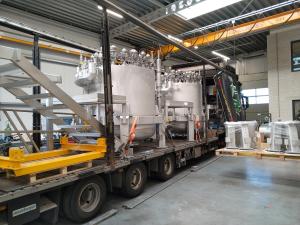Cold valve boxes for the ITER cryopumps
Regulating this flow of supercritical helium are the cold valve boxes associated with each pump. Equipped with cryogenic valves (25 per unit), relief systems, and sensors for pressure and temperature, these components will manage cryogenic fluids in a wide range of temperatures—from super-cold (-269 °C) to fairly hot (230 °C).
High magnetic field, radiation, and space were part of the design constraints. The position of the cold valve boxes in the machine imposed special constraints on materials and welding, while regular "regeneration periods" for each pump complicated their design.
Cryoworld has already shipped four of eight units to Research Instruments, where final electrical wiring and connections will be installed, and factory acceptance testing carried out. Delivery to ITER is expected before the end of the year.
See the original story on the Fusion for Energy website.



